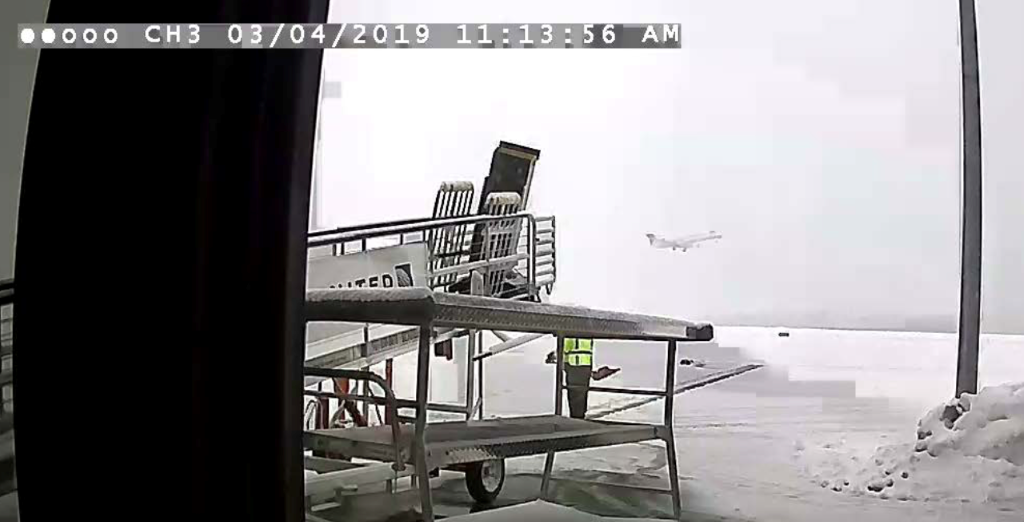
In Part 1, we discussed the circumstances surrounding the off-runway landing at Presque Isle, Maine.
The National Transportation Safety Board conducted what is commonly known as a “field major” investigation, later categorized as a limited (Class 3) investigation. It was assisted by the FAA, CommutAir and the Air Line Pilots Association. The investigation took three years and four months to conclude and no recommendations were issued.
The airplane came to rest 3,600 ft. beyond the approach threshold, 305 ft. to the right of the runway centerline, and 230 ft. to the right of the right runway edge.
An Airworthiness group visited the accident site the day after the accident and spent three days documenting the wreckage.
Much of the airplane was intact. There was obvious damage to the nose, which was damaged back to the first bulkhead on top and back to the nose gear position on the bottom. The nose gear wheels were located aft of their normal position; there were scuffs, dents and scratches on the wing leading edges; and there were broken flap jackscrews. There were cracks and shifts in flap panels. The airplane’s localizer antenna appeared to be undamaged.
The left main landing gear was lodged between the left engine nacelle and the fuselage, and the right engine inlet was damaged. There was minor interior cabin damage, the most notable of which was two small holes in the fuselage wall near seat 24A.
In addition to the two crash recorders, ADS-B data was available from the FAA.
A performance specialist and an ATC specialist used that data to reconstruct the flight path. An air traffic control group met with staff from Boston Center to discuss what happened from ATC’s point of view.
They learned that a crew had reported the localizer discrepancy to the Center after landing at KPQI on March 2, two days before the accident. During an approach to Runway 1, the pilot noticed a significant localizer offset to the right. His call to the Center was recorded.
He said there was a “good offset the right of the localizer there all the way down—ah—became visual about ah two thousand five hundred or so and ah once we were center with the runway the localizer was about half dot off all the way to the ground.”
The controller acknowledged the report and said he would pass it on.
The ATC group interviewed the FAA National Airspace Systems operations manager. He had received the message but declined to follow up because FAA procedure is to confirm any report of a navaid malfunction with a second report before taking action.
There were no flights into KPQI after the one that reported the discrepancy.
The FAA conducted a post-accident flight inspection of the KPQI ILS on March 7 and found that the localizer was indeed out of tolerance by 200 ft. to the right.
They also found a glideslope anomaly. After snow was cleared from around and in front of the localizer and glideslope antennas, the ILS was retested on March 13 and the signals were within normal tolerances.
An NTSB airport specialist investigated events that took place at KPQI before, during and after the accident.
He obtained airport surveillance videos that showed the airplane going around and later enveloped in a snow cloud during the landing. He learned that the lightning arrestor atop the wind sensor pole of the AWOS installation was bent. The only reasonable conclusion was that it was struck by the airplane, although the NTSB declined to say so.
KPQI maintenance staff scraped off the snow around the antennas using bulldozers and a tractor. It took over 15 hr. Before beginning to plow, they measured snow depths in front of the localizer antenna. There were four berms or ridges in front of the antenna that rose as high as 4.9 ft.
Airport operations staff reported that there had been localizer signal problems in previous years, and they had been resolved by FAA technical personnel.
Typically, when a signal was out of compliance, they removed snow. However, they never knew exactly how much to remove.
The FAA’s Advisory Circular on Field Conditions (AC 150/5200-30D) specified snow clearance values for glideslope antennas, but not localizer antennas. Eight months after the accident, the FAA modified the AC to set 2 ft. as the limit of snow before a localizer antenna must be evaluated.
In Part 3, we’ll discuss the flight crew’s background and the NTSB’s conclusions about the accident.






Comments